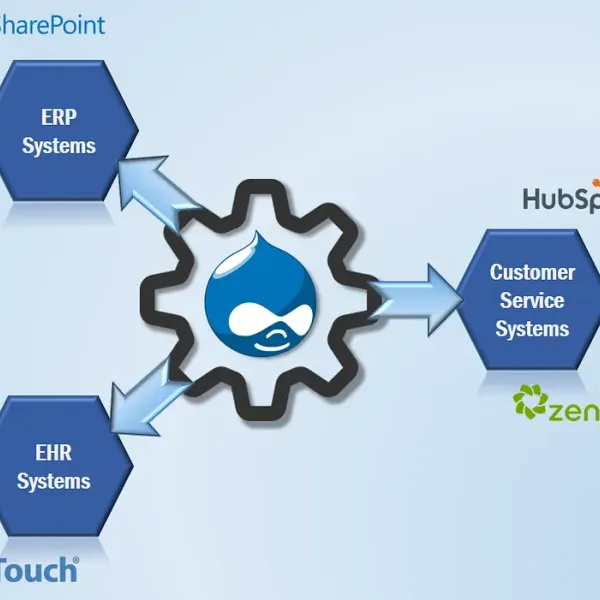In today’s digital world, no business platform operates in isolation. Your website isn’t just a digital brochure anymore — it’s the hub where marketing, sales, customer service, and operations come together.
That’s why integrating your Drupal website with other business tools — such as CRMs, payment systems, email marketing platforms, and analytics services — can unlock new levels of efficiency and customer engagement.
Why Integrations Matter for Your Business
When systems don’t talk to each other, teams waste hours copying data, customers face frustrating experiences, and growth opportunities are missed. Drupal integrations solve this by creating seamless connections between your website and the tools you already use.
Some benefits for business owners include:
- Streamlined operations → Eliminate manual data entry by syncing customer information directly into your CRM.
- Faster payments → Accept transactions through trusted providers like PayPal or Stripe.
- Smarter marketing → Send personalized campaigns by connecting Drupal with Mailchimp or HubSpot.
- Better insights → Gain a complete view of customer behavior with integrations to Google Analytics or other reporting tools.
- Customer satisfaction → Provide smoother, more consistent experiences across channels.
Common Integration Examples
Here are a few ways businesses use Drupal as their digital hub — along with modules available on Drupal.org:
- CRM Integration
- Salesforce Suite → Sync contacts, leads, and campaigns between Drupal and Salesforce.
- HubSpot → Connect Drupal forms and user data with HubSpot’s marketing and sales tools.
- E-commerce & Payments
- Drupal Commerce → A complete e-commerce framework for Drupal.
- Commerce Stripe and Commerce PayPal → Accept secure online payments.
- Ubercart → Another popular shopping cart system for Drupal.
- Email Marketing
- Mailchimp → Add sign-up forms and automatically sync subscribers.
- Simplenews → Manage newsletters directly within Drupal.
- Analytics & Tracking
- Google Analytics → Track site performance and visitor behavior.
- Google Tag Manager → Easily manage marketing and tracking scripts.
- Matomo Analytics → Privacy-friendly analytics alternative to Google.
- Third-Party Content & APIs
- Feeds → Import content from external sources (CSV, XML, JSON).
- JSON:API → Expose Drupal content to other systems and consume external APIs.
- RESTful Web Services → Build custom connections with external platforms.
Approaches to Integration
Drupal offers several ways to connect with outside systems:
- Ready-to-Use Modules
Many popular services already have plug-and-play solutions. If your business uses a common platform, chances are the Drupal community has a module for it. - Custom Integrations
For unique needs or proprietary systems, developers can create tailored solutions that align perfectly with your workflows. - Middleware Solutions
Tools like Zapier or Make (Integromat) act as bridges, connecting Drupal with dozens of other platforms without heavy development work.
Best Practices for Business Success
When planning Drupal integrations, following best practices ensures not only technical stability but also long-term business value.
- Security First
- Your website often handles sensitive data such as customer details and payment information. A single breach can lead to financial loss and reputational damage.
- What to do: Always use secure authentication methods (like OAuth2 or API keys), keep modules up to date, and ensure payment processing is done through trusted providers (Stripe, PayPal) rather than storing data on your servers.
- Scalability
- As your business grows, so does the amount of traffic, data, and connected services. An integration that works for 1,000 customers may break at 100,000.
- What to do: Choose solutions that support caching, asynchronous processing, and API limits. Look for modules with proven community adoption rather than one-off experiments.
- Reliability & Monitoring
- If integrations fail silently—like a form not sending leads to your CRM—you lose revenue opportunities without even knowing it.
- What to do: Set up monitoring, logging, and alerts so failures are visible. Use Drupal’s built-in logging system (Reports > Recent log messages) and, for critical systems, consider external monitoring tools.
- User Experience Consistency
- Customers expect smooth, consistent experiences. If checkout fails due to a payment integration issue or if email signups never reach your mailing list, trust is lost.
- What to do: Regularly test integrations from the customer’s perspective. Make sure error messages are clear, not just technical jargon.
- Maintainability & Long-Term Support
- Integrations are not a one-time project. APIs change, services update their rules, and modules need patches. If maintenance is ignored, integrations may break at critical times.
- What to do: Favor well-supported modules with active contributors. If building custom integrations, insist on documentation so future developers can maintain them easily.
- Clear Business Goals
- Not every integration adds value. A shiny new connection that doesn’t support your business objectives is wasted effort.
- What to do: Start with the business case—whether that’s reducing manual data entry, increasing conversion rates, or improving customer insights—and design integrations around those goals.
The Business Impact
A well-integrated Drupal site can transform your digital strategy:
- Sales teams get warmer leads, faster. With integration (e.g., Drupal + Salesforce or HubSpot), leads flow instantly into the CRM, allowing sales reps to follow up quickly while prospects are still engaged. This shortens the sales cycle and increases conversion rates.
- Marketing campaigns become more targeted and effective. Marketers can automatically segment audiences, send personalized messages, and track engagement. This boosts open rates, click-throughs, and overall ROI.
- Customers enjoy frictionless experiences, from browsing to checkout. With well-integrated e-commerce and payment modules (e.g., Commerce + Stripe/PayPal), the checkout process is smooth, secure, and reliable. Happy customers are more likely to return and recommend your business.
- Executives gain better data for decision-making. By automating data flows (e.g., Drupal + ERP or accounting systems), businesses free up employees to focus on higher-value tasks, reducing costs and improving accuracy.
In other words, integrations don’t just save time — they unlock new opportunities for growth.
Final Thoughts
Drupal is more than a CMS — it’s a business platform that can connect all your digital tools into one powerful ecosystem. By integrating your website with the services your business depends on, you reduce inefficiencies, improve customer experiences, and set the stage for long-term success.
Whether through ready-made modules, custom development, or smart middleware, integrations are one of the smartest investments you can make in your digital strategy.





